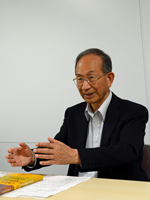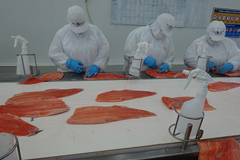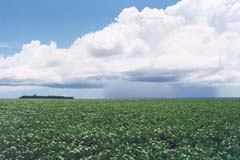InterviewJICA-RI Focus Vol. 39 - Interview with Akio Hosono, Senior Research Advisor
2017.07.26
The JICA Research Institute (JICA-RI) publishes the "Project History" series (Japanese only) to look back on international cooperation through various schemes implemented by JICA. The series serves as a compilation of analysis of the projects’ history and outcomes. The first entry in the series was "Nanbei chiri wo sake yushutsu taikoku ni kaeta nihonjintachi" (The Japanese people who contributed to Chile’s transformation into a major salmon exporting country) written and edited by Senior Research Advisor Akio Hosono. An English-language version of the book, together with chapters written by Chilean and Japanese scholars, was also published in 2016 under the title "Chile's Salmon Industry: Policy Challenges in Managing Public Goods." We asked him about Japan’s contributions to Chile’s salmon industry as seen through the book.

■ Profile
PhD in Economics. Hosono’s career includes: Institute of Developing Economies, Japan External Trade Organization; The United Nations Economic Commission for Latin America and the Caribbean; Professor, University of Tsukuba (Policy and Planning Sciences); Professor, Research Institute for Economics and Business Administration, Kobe University; Japanese Ambassador to El Salvador; Senior Advisor, JICA; Professor, National Graduate Institute for Policy Studies; and Director, JICA Research Institute. He has been in his current position since 2013.
- How did you come to write a book about Japan’s contributions to Chile’s salmon industry?
Chile is currently second only to Norway in worldwide salmon exports. About 30% of the salmon consumed by the Japanese comes from Chile. However, there were originally no salmon in Chile. Japan’s support is behind the growth of Chile into a major salmon exporter. For about 20 years starting in the 1970s, JICA implemented a series of technical cooperation projects focused on salmon farming technology (hereinafter "Japan-Chile Salmon Project") to introduce salmon to Chile.
I began compiling the results of the Japan-Chile Salmon Project into a book in a series "Project History" in 2007, about 20 years after the project ended. I lived in Chile for a little more than ten years when I was working on the United Nations Economic Commission for Latin America and the Caribbean. The remarkable growth of the salmon industry there has garnered a significant amount of attention, so I thought I should study the nature of contribution of Japan’s cooperation from a long-term perspective.
The Japan-Chile Salmon Project began in the 1970s and ended in 1989. I started writing the book in 2007, so from the time the project began, about 40 years have actually passed. I decided to write the book from two perspectives. First was asking how Japan’s cooperation contributed to Chile’s societal and economic growth through development of the salmon industry. Second was asking how it contributed to improving the capabilities of Chile’s industrial human resources including our counterparts, private businesses, and others. I interviewed key persons in a variety of fields. On the Japan side, I interviewed Ariaky Nagasawa, who was involved for many years from the start of the project, and others. On the Chile side, I interviewed Pablo Aguilera, who participated in training in Hokkaido in 1970 and was subsequently involved in the Japan-Chile Salmon Project, and others. I was determined to compile everything objectively, and in 2010, I was able to publish the book.
- What led to publication of the English-language version of "Chile's Salmon Industry: Policy Challenges in Managing Public Goods"?
From the beginning, there were some who suggested making an English translation of the Japanese version of a book on Chile’s salmon industry, but I was unable to start on it. The reason is that I had begun research on agriculture in the Cerrado in Brazil. In 2012, two years after publication of the Japanese book on the Japan-Chile Salmon Project, we released the Japanese book on the Cerrado that I wrote with Yutaka Hongo as part of the "Project History” series. At a side event of the United Nations Conference on Sustainable Development (Rio+20) held in Rio de Janeiro, Brazil, that year, we presented the English-language version of the book on Cerrado and we found the book met with a favorable reception. So momentum to publish an English-language version of the book on the Japan-Chile Salmon Project was building. However, rather than merely translating the Japanese-language version into English, I decided to write and edit the book anew for publication, with researchers from Chile involved as well.

More than 20 years of Japan's cooperation made salmon farming a major industry in Chile
In addition, about 30 years after the end of the Japan-Chile Salmon Project, Chile’s salmon industry was facing a new phase, including outbreaks of infectious salmon anemia (ISA) and other diseases, as well as environmental issues. I thought if we were going to publish an English-language version anyway, we could create the first compilation on Chile’s salmon industry that covered everything from its history to its current state, by including issues that are being tackled today. I edited the book with Jorge Katz, a professor at the University of Chile and Michiko Iizuka, a research fellow at Maastricht Economic and Social Research and Training Center for Innovation and Technology, the United Nations University, and it was published in 2016. Although the salmon industry is extremely important to Chile, there were no books that covered the entire history of its growth in a single volume, so the Chile side welcomed publication of the book.
As we worked on the editing, I was reminded that people who were involved in the Japan-Chile Salmon Project are still active as leaders in the salmon industry. Mario Puchi, one of those who played a central role in the project, founded a private company named Aqua Chile with the participation of Aguilera and others, and has since then grown it into Chile’s largest salmon farming company. The company actively conducts research and development, even launching a company for that purpose, and is striving to contribute to the further growth of the salmon industry. This might be an example showing that the Japan-Chile Salmon Project contributed significantly to the development of human resources for the industry.
JICA-RI held launch seminars in April 2017 in Santiago, the capital of Chile, and in Puerto Montt, a city in Southern Chile with a thriving salmon farming industry. The purpose of the seminar was to commemorate the publication of the English-language version, and was attended by people involved in the salmon industry in Chile and Japan. While ISA has been addressed, new efforts are needed due to the abnormal generation of algae and toxic red tide caused by El Niño and other factors. At the seminar, Takeshi Hara (Chief Director of Japan Fisheries Science & Technology Association) talked about the former situation in Chile when he was engaged in the Japan-Chile Salmon Project around 30 years ago as a fish disease expert, and Motohiko Sano (Professor, Tokyo University of Marine Science and Technology) talked about the nature of aquaculture in Japan and introduced red tide hazard countermeasures. Opinions were exchanged regarding how to grow a sustainable, environmentally friendly salmon industry.
With the relevant parties all gathered together on the occasion of publication seminar of the English-language version, including Hara and his Chilean counterpart, we gained a renewed awareness of the significance of the cooperation between Japan and Chile, and how Chileans and Japanese worked together at the time in a variety of areas, not only in salmon farming technology, but also domestic production of eggs, measures against disease and development of feed.
As part of the cooperation between the two countries in the future, "Characterization of Fish-Killing Algae Bloom Holobiome and the Development of a Detection/Prediction System for Industry/Government/Academia Salmon Aquaculture" has been selected as a fiscal 2017 project for the Science and Technology Research Partnership for Sustainable Development (SATREPS) conducted by JICA and the Japan Science and Technology Agency (JST). The study aims to elucidate the mechanism of harmful red tide in Chile—from the viewpoints of both environment and microbiology. I am glad that the seminar was the catalyst for the start of new cooperation.
- What are you currently working on?
I am currently working with a team of people with strong ties to Paraguay to write a book in Japanese on the activities of Japanese immigrants and Japanese cooperation in Paraguay. In the past, Paraguay had a monocultural economy that depended on cotton growing, but in recent years it has seen multifaceted industrial growth in agriculture and agricultural processing with a main focus on soy beans, as well as in the manufacturing industry, such as automotive parts. Paraguay has grown into an export country for soy beans, corn, sesame seeds, wheat, meat, and many other items. It is now the world’s fourth largest exporter of soy beans. We plan to compile information on the Japanese immigrants and JICA’s international cooperation that contributed to that process of development.

A barren land of the "Cerrado" in Brail was transformed into a productive agricultural areas
In addition, "Developing for Sustainable Agriculture: The Brazilian Cerrado," an English-language book on agriculture in the Cerrado, was published in 2016 as well, but the Cerrado is expansive, and the characteristics of areas within the Cerrado differ significantly, so I have a deep sense that deeper research into these matters is needed. Currently, a team of researchers from Brazil and Japan is conducting such research, and we are considering publication of a new book in English.

事業事前評価表(地球規模課題対応国際科学技術協力(SATREPS)).国際協力機構 地球環境部 . 防災第一チーム. 1.案件名.国 名: フィリピン共和国.

事業事前評価表(地球規模課題対応国際科学技術協力(SATREPS)).国際協力機構 地球環境部 . 防災第一チーム. 1.案件名.国 名: フィリピン共和国.

事業事前評価表(地球規模課題対応国際科学技術協力(SATREPS)).国際協力機構 地球環境部 . 防災第一チーム. 1.案件名.国 名: フィリピン共和国.

事業事前評価表(地球規模課題対応国際科学技術協力(SATREPS)).国際協力機構 地球環境部 . 防災第一チーム. 1.案件名.国 名: フィリピン共和国.

事業事前評価表(地球規模課題対応国際科学技術協力(SATREPS)).国際協力機構 地球環境部 . 防災第一チーム. 1.案件名.国 名: フィリピン共和国.
scroll